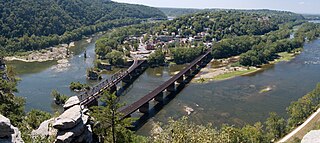
Harpers Ferry National Historical Park, originally Harpers Ferry National Monument, is located at the confluence of the Potomac and Shenandoah rivers in and around Harpers Ferry, West Virginia. The park includes the historic center of Harpers Ferry, notable as a key 19th-century industrial area and as the scene of John Brown's failed abolitionist uprising. It contains the most visited historic site in the state of West Virginia, John Brown's Fort.

The Henry K. List House, also known as the Wheeling-Moundsville Chapter of the American Red Cross, is a historic home located at 827 Main Street in Wheeling, Ohio County, West Virginia. It was built in 1858, and consists of a two-story square main block with an offset two-story rear wing. The brick mansion features a low-pitched hipped roof with a balustraded square cupola. It has Renaissance Revival and Italianate design details. The building was once occupied by the Ohio Valley Red Cross.

The William Miles Tiernan House, also known as the Tiernan-Riley House, is a historic home located at Wheeling, Ohio County, West Virginia. It was built in 1900–01, and is a 2+1⁄2-story, L-shaped, Georgian Revival-style brick dwelling. It features two-story Ionic order pilasters that flank the one-story entrance portico. The house was built for William M. Tiernan, who was vice-president of the Bloch Brothers Tobacco Company.

Mount Airy, near Warsaw in Richmond County, Virginia, constructed in 1764 for Colonel John Tayloe II, perhaps the richest Virginia planter of his generation, is a mid-Georgian plantation house, the first built in the manner of a neo-Palladian villa. John Ariss is the attributed architect and builder. Tayloe's daughter, Rebecca and her husband Francis Lightfoot Lee, one of the only pair of brothers to sign the Declaration of Independence are buried on the estate, as are many other Tayloes. Before the American Civil War, Mount Airy was a prominent racing horse stud farm, as well as the headquarters of about 10-12 separate but interdependent forced-labor plantations along the Rappahannock River. Mount Airy is listed on the National Register of Historic Places as a National Historic Landmark as well as on the Virginia Landmarks Register and is still privately owned by Tayloe's descendants.

The James Semple House is a historic house on Francis Street in Colonial Williamsburg, Williamsburg, Virginia. Built about 1770, it is a prominent early example of Classical Revival residential architecture, whose design has been attributed to Thomas Jefferson. It was declared a National Historic Landmark in 1970.

Sabine Hall is a historic house located near Warsaw in Richmond County, Virginia. Built about 1730 by noted planter, burgess and patriot Landon Carter (1710–1778), it is one of Virginia's finest Georgian brick manor houses. Numerous descendants served in the Virginia General Assembly. It was added to the National Register of Historic Places in 1969, and declared a National Historic Landmark in 1970. At the time of its National Register listing, still owned by Carter / Wellford descendants.

The Kennedy Farm is a National Historic Landmark property on Chestnut Grove Road in rural southern Washington County, Maryland. It is notable as the place where the radical abolitionist John Brown planned and began his raid on Harpers Ferry, Virginia, in 1859. Also known as the John Brown Raid Headquarters and Kennedy Farmhouse, the log, stone, and brick building has been restored to its appearance at the time of the raid. The farm is now owned by a preservation nonprofit.
Brown House may refer to:

Beall-Air, also known as the Colonel Lewis William Washington House, is a two-story stuccoed brick house in classical revival style near Halltown, West Virginia. It was the home of Colonel Lewis William Washington, great-great nephew of President George Washington and hostage in John Brown's raid on Harpers Ferry, West Virginia.

The Allstadt House and Ordinary was built about 1790 on land owned by the Lee family near Harpers Ferry, West Virginia, including Phillip Ludwell Lee, Richard Bland Lee and Henry Lee III. The house at the crossroads was sold to the Jacob Allstadt family of Berks County, Pennsylvania in 1811. Allstadt operated an ordinary in the house, and a tollgate on the Harpers Ferry-Charles Town Turnpike, while he resided farther down the road in a stone house. The house was enlarged by the Allstadts c. 1830. The house remained in the family until the death of John Thomas Allstadt in 1923, the last survivor of John Brown's Raid.

Huntley, also known as Historic Huntley or Huntley Hall is an early 19th-century Federal-style villa and farm in the Hybla Valley area of Fairfax County, Virginia. The house sits on a hill overlooking Huntley Meadows Park to the south. The estate is best known as the country residence of Thomson Francis Mason, grandson of George Mason of nearby Gunston Hall. It is listed on the National Register of Historic Places (NRHP), the Virginia Landmarks Register (VLR), and the Fairfax County Inventory of Historic Sites.

Dr. George Rigas House is a historic home located at Weirton, Hancock County, West Virginia. It was built in 1936, and is a five-bay, 2+1⁄2-story wood-frame house with clapboard siding and a side gable roof. It has an eclectic style. It features a gable-roofed portico centered on the main elevation and supported by four Tuscan order columns and two pilasters. The house is associated with Dr. George S. Rigas, a prominent local physician who practiced medicine in Weirton.
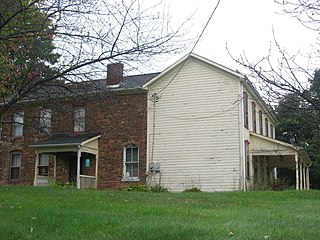
Danforth Brown House, also known as Old Worrell Farm, is a historic home located near Wellsburg, Brooke County, West Virginia. It is a two-story, five bay, brick and frame I house form dwelling in the Italianate style. The original section was built in 1823, with additions built in the 1870s. It sits on a sandstone foundation. Also on the property is the original spring house.
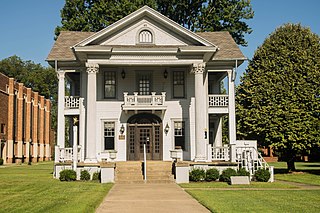
Canty House, also known as "The Magnolia," is a historic home located on the campus of West Virginia State University at Institute, Kanawha County, West Virginia. It was built about 1900, as a simply designed, two-story frame farm house. In 1923, it was remodeled to its present form in the Classical Revival style. It has flanking two-story side galleries and a center pedimented pavilion. It features a two-story portico supported by two Corinthian order columns. It was originally the home of "Colonel" James M. Canty, one of the early instructors at the West Virginia Colored Institute.
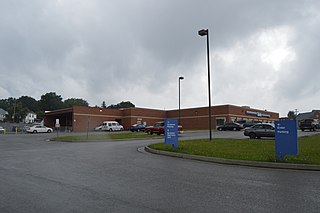
Dr. James W. Hale House, also known as the Hale-Pendleton House, "Temple Knob," and "Temple Hill," was a historic home located at Princeton, Mercer County, West Virginia. Built about 1885, it was a large, two-story plus basement brick house. The house had many Gothic Revival features, such as pointed-arch windows with panes divided by simple geometric tracery, gingerbread bargeboards, and a large verandah completely around the west and south elevations. The verandah roof was supported by more than 12 fluted columns and a cornice with dentil molding in the Greek Revival style. The house sat atop Temple Knob, a small rise said to have been used as a signal point by both Union and Confederate soldiers during the American Civil War.

Dr. Robert B. McNutt House is a historic home located at Princeton, Mercer County, West Virginia. The original section was built about 1840, and is a classic I house configuration, with a two-story, three-bay main facade and a one-bay-wide, two-story centered portico. Later additions include a one-story, hip-roofed section and a two-story ell. The portico has curvilinear brackets and a second story railing in the Gothic Revival style. The house sits on a random ashlar sandstone foundation. Also on the property is a contributing stone storage building / well house. The house was used as a headquarters and field hospital by the Union Army in the spring of 1862.
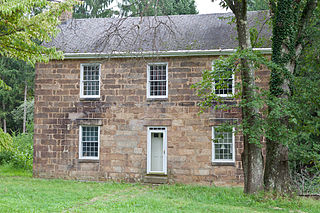
Col. Thomas Brown House is a historic home located near Reedsville, Preston County, West Virginia. It was built in 1837, and is a two-story, sandstone Federal style dwelling. It measures 40 feet wide and 20 feet deep and has a gable roof.
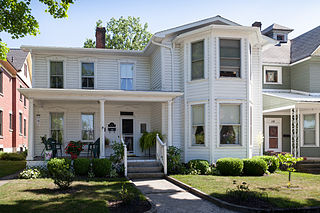
Dr. John C. Irons House, also known as the Dr. S. G. Moore Home, is a historic home located at Elkins, Randolph County, West Virginia. It was built in 1889, and is a two-story Italianate frame dwelling with drop wood siding, a brick foundation and a "T"-shape plan with rear one-story addition. It has a low pitched gable end to the side with a two-story projecting angled bay added about 1911.

Farmer's Delight was built in Loudoun County, Virginia in 1791 by Colonel Joseph Flavius Lane. The Federal style brick plantation house incorporates elements of Georgian architecture. The house is now closely associated with American oilman and diplomat George C. McGhee, who owned the property after 1948. The house is maintained by the McGhee Foundation and is listed on the National Register of Historic Places.

The Craig and Virginia Sheaffer House, also known as the John and Marion Keenan House, is a historic residence located in Fort Madison, Iowa, United States. It was listed on the National Register of Historic Places in 1993.





















